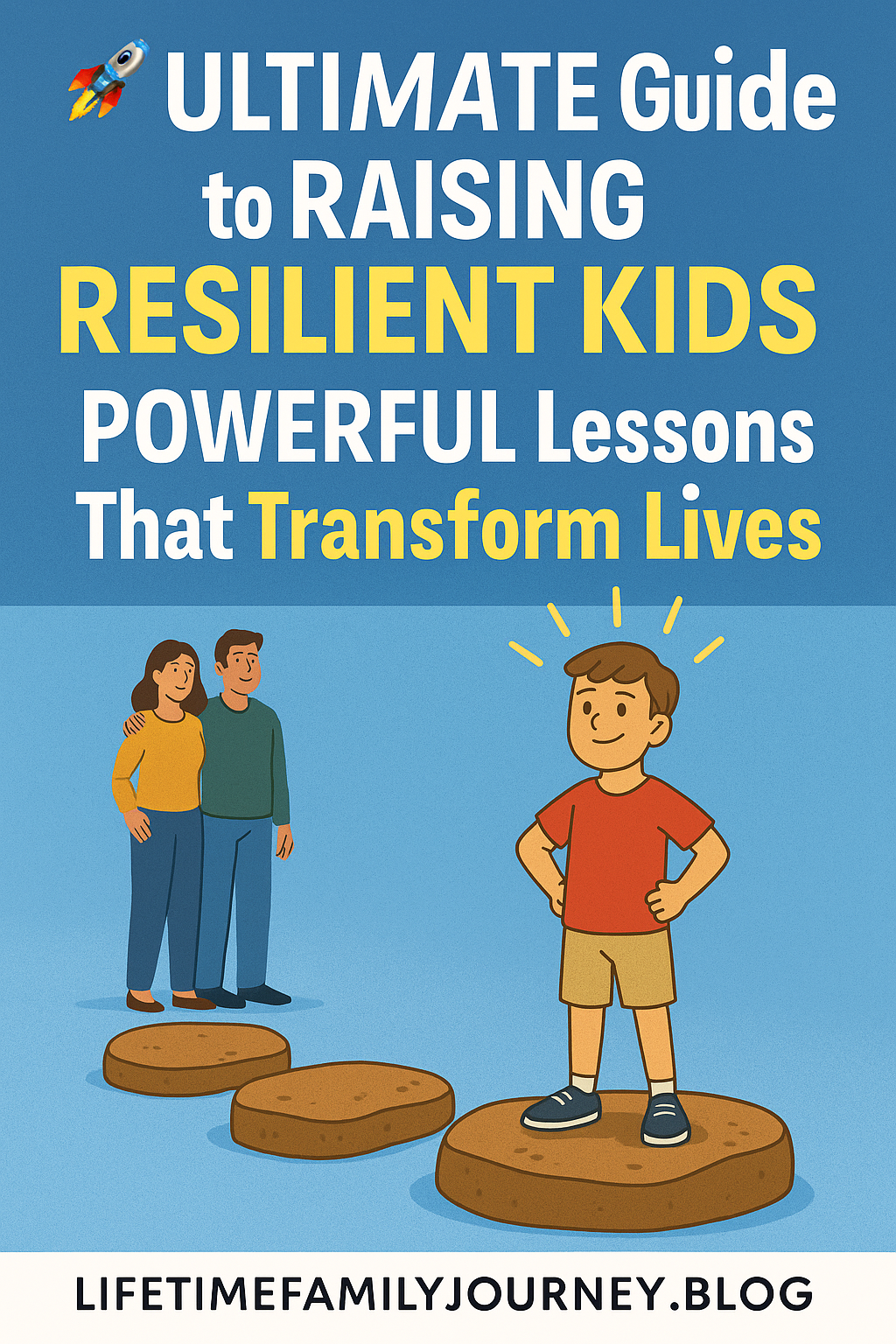🚀 ULTIMATE Guide to Raising Resilient Kids: POWERFUL Lessons That Transform Lives

Last Saturday, I watched my 8-year-old daughter fall off her bike—hard. My first instinct? Sprint over and check for damage. Instead, I stayed put. She picked herself up, dusted off her knees, and climbed back on. That moment reminded me why raising resilient kids isn’t about preventing every fall—it’s about teaching them how to get back up.
As a dad of six (five daughters and one son), married to a middle school math teacher for over 20 years, I’ve learned that resilient kids aren’t born—they’re built. After two decades of military service and countless parenting tips that either worked brilliantly or failed spectacularly, I’ve discovered that the most important gift we can give our children isn’t comfort—it’s capability. 💪
Research from Harvard’s Center on the Developing Child shows that children who develop resilience have had at least one stable, committed relationship with a supportive adult. That’s where you come in. Your job isn’t to shield them from every challenge—it’s to prepare them to face whatever comes their way.
🛡️ The SHOCKING Problem With Bubble-Wrapped Childhoods

Today’s kids are growing up in a world where comfort and convenience are the default. That sounds great—until it isn’t. Overprotection, constant entertainment, and risk-averse parenting tips can backfire spectacularly. Raising resilient kids means understanding that resilience isn’t built through safety nets—it’s built through falling, figuring it out, and standing back up. 🎯
When everything is padded for them, kids don’t learn how to process failure or sit in discomfort. If they never hear “no” or feel the sting of disappointment, real life will blindside them later. Emotional regulation skills are like muscles—they need training to grow strong.
Research confirms that learning to cope with manageable threats—or positive stress—is critical for developing resilience. This isn’t about throwing them into overwhelming circumstances. We’re talking about giving them space to stretch, take risks, and sometimes fail—while knowing you’re there as a safety net, not a helicopter. 🚁
Challenge Points:
- Stop solving problems your resilient kids can solve themselves ✋
- Let boredom happen—it sparks creativity 🧠
- Replace “protect at all costs” with “prepare to stand strong” 💯
⚡ Let Them Feel the Consequences (Without CRUSHING Them)
Natural consequences are often the best teachers. Forgot your coat? You’re cold. Didn’t study? The grade reflects that. These lessons don’t require yelling or lectures—just consistency. The goal isn’t to punish; it’s to give space for cause and effect to do its job. 📚
This doesn’t mean being cold or dismissive. It means backing off enough to let the lesson land. Most kids want to succeed and do well, but they need to experience the cost of poor choices in a safe environment before the real world raises the stakes. Raising resilient kids requires us to resist the urge to soften every blow.
Resilient kids who feel the weight of their own actions learn accountability. This builds emotional regulation and internal motivation instead of relying on fear of punishment or external rewards. When they know they own the results of their behavior, their decision-making becomes more intentional. 🎯
You can reinforce this growth by giving them reflection tools. Consider having them keep a simple “What Happened vs. What I’ll Try Next” journal to log outcomes and build awareness. These parenting tips shift the focus from blame to growth.
POWERFUL Parenting Tips:
- Follow through—don’t bail them out every time 🚫
- Use phrases like, “That must be frustrating. What will you do next time?” 🤔
- Guide, don’t rescue ⛑️
- Help them track outcomes with reflection journals 📝
- Use calendars to visualize cause and effect 📅
- Don’t revisit mistakes with guilt or sarcasm—just move forward ➡️
🔥 Embrace the INCREDIBLE Power of “Not Yet”
We tend to praise kids for being “smart” or “talented,” but those labels can backfire. When challenges come, they panic—because they’ve learned that effort means they’re not naturally good. Enter the growth mindset for raising resilient kids.
“Not yet” turns failure into progress. It tells kids that struggling doesn’t mean they’re broken—it means they’re learning. This mindset builds grit, confidence, and long-term motivation in resilient kids. 🌱
Encouraging this mindset means helping your kids shift from fixed beliefs (“I’m just not good at math”) to flexible thinking (“I haven’t figured this out yet, but I can learn”). This isn’t about fake positivity—it’s about showing them how persistence leads to mastery. 📈
GAME-CHANGING Tools for Raising Resilient Kids:
- Praise effort, not just results 👏
- Replace “I can’t do this” with “I can’t do this… yet” ⏰
- Model your own learning curve out loud 🗣️
- Share stories of famous failures who became successes 🌟
- Celebrate mistakes as evidence of effort 🎉
💬 Normalize Discomfort and Talk About HARD Things
Life is uncomfortable. Good. Let it be. Normalize hard conversations at the dinner table. Talk about emotions without shame. Let your kids see you struggle, regroup, and try again. If everything always looks easy from the outside, they won’t know how to process their own pain. 😤
Harvard Health research shows that safe, stable relationships with caring adults act as potent buffers against stress. Emotional regulation comes from exposure and support, not avoidance. When your child sees that you have tough days, feel discouraged, or make mistakes—and they also see you recover—you give them permission to be human.
Instead of shielding them from sadness, anxiety, or stress, walk through it with them. That shared vulnerability becomes a training ground for connection and coping. This is crucial for raising resilient kids who can handle life’s curveballs. 🌪️
IDEAS to Try:
- Share age-appropriate challenges from your own life 📖
- Don’t rush to “fix” their feelings—sit with them in it 🤗
- Talk about anxiety, mistakes, and failure openly 💯
- Use a “feelings wheel” to help them identify emotions 🎡
- Ask where in their body they feel different emotions 🧘
🧠 Try This: Ask your child to name their emotion using a feelings wheel, then ask where in their body they feel it. This simple tool teaches emotional regulation without shame and builds a language for self-awareness.
🎯 Teach CRITICAL Thinking Over Blind Obedience
Raising resilient kids means teaching them how to think, not just what to think. That starts with giving them space to question, wonder, and even disagree. The goal isn’t to raise a robot—it’s raising a kid who can assess, adapt, and stand their ground. 🤖
Blind obedience might feel easier in the moment, but it can raise adults who are either passive or reactive. These parenting tips focus on teaching them to be thoughtful, not just compliant.
Helping your child become a confident decision-maker means giving them more responsibility in how they solve problems. Resilient kids learn that actions have layers, and not every answer is black and white. Let them wrestle with ethics, fairness, and problem-solving—even if they land somewhere different than you. 🤔
Build Their Thinking Muscles:
- Ask open-ended questions instead of giving answers ❓
- Encourage respectful debate—let them challenge ideas 💭
- Teach them how to research, reason, and reflect 🔍
- Watch documentaries together, then discuss the creator’s perspective 🎬
- Have them compare multiple sources on a topic and share their conclusions 📊
💪 Give Them REAL Responsibilities (And Expect Them to RISE)
Resilient kids feel confident when they know they’re capable. One of the fastest ways to build that? Let them carry real weight. Exciting chores for kids isn’t just about getting help around the house—it’s about letting them contribute meaningfully to family routines. 🏠
Responsibility fosters independence, self-efficacy, and pride. Kids want to feel needed. They want to know their role matters. When they take ownership of tasks, they build identity and confidence in their abilities. This is fundamental to raising resilient kids who see themselves as capable contributors.
Yes, they’ll mess up. But the correction process is where learning takes root. The more we hand them real responsibilities and believe they can handle it, the more likely they are to rise to the occasion. 📈
RESPONSIBILITY Ideas:
- Create age-based chore charts with accountability ✅
- Let older kids plan a meal or manage a small budget 💰
- Involve them in fixing, building, or problem-solving around the house 🔧
- Give them ownership of specific household systems 📋
- Let them teach younger siblings new skills 👨👩👧👦
🌟 Model Resilience Like It’s Your JOB (Because It IS)
You can’t teach what you don’t show. If you want resilient kids, be a resilient adult. That means owning your failures, adjusting course when things break, and showing emotional regulation when you’re overwhelmed. They’re watching you more than they’re listening to you. 👀
Modeling resilience isn’t about being perfect—it’s about being consistent. When you say, “I messed that up, but I’m going to try again,” you plant seeds of perseverance in your kids. When you acknowledge your stress and still show up, you teach them to be present even when it’s hard.
These parenting tips transform your daily life into a classroom. What lessons are they learning from how you handle pressure, disappointment, or change? Are you modeling the emotional regulation you want to see from them? 🎭
Reflection Prompts:
- How do you handle stress in front of your kids? 😰
- Do they see you apologize and try again? 🙏
- Are you modeling coping strategies, or masking everything? 🎭
- What would they say about how you handle setbacks? 🤷♂️
⚔️ Don’t Fear the FIGHT: Resilience Is Built in the Struggle
This isn’t about making life harder for the sake of it. It’s about not shielding them from every difficulty. Struggle is the forge where resilience is formed. The goal isn’t a smooth road—it’s raising resilient kids who can walk whatever road they end up on. 🛤️
We build resilient kids by letting them wrestle with age-appropriate adversity. That could be dealing with a tough coach, managing a bad grade, or navigating a friendship conflict. Every uncomfortable situation is a training opportunity for emotional regulation. Let the friction shape them. 🔥
It’s perfectly fine to be there on the sidelines. You can coach and encourage. But the growth happens when they do the work themselves. Sometimes that means letting them fall and watching them rise stronger. 💥
The key is matching the challenge to their developmental stage. A five-year-old learning to tie their shoes faces different struggles than a fifteen-year-old managing social drama. Both are building resilience, just at different levels.
🏗️ The Long Game: Building CHARACTER Through Consistent Practice
Raising resilient kids isn’t a sprint—it’s a marathon. The habits you build today will serve them for decades. This means thinking beyond immediate compliance to long-term character development. 🏃♂️
Consider how family routines that work can support resilience building. When resilient kids know what to expect and have systems they can rely on, they feel more confident tackling new challenges. Structure actually creates space for healthy risk-taking.
Recent research examining adolescent stress during COVID-19 found that supportive family relationships built over time can buffer the effects of stressful, disruptive experiences. These parenting tips focus on the long-term payoff of consistent investment. 📊
Long-term STRATEGIES:
- Focus on character over convenience 🎭
- Celebrate effort and improvement over perfection 🎉
- Build systems that support independent thinking 🧠
- Create opportunities for age-appropriate leadership 👑
- Teach them to self-evaluate and adjust 🔄
💥 When Resilience Meets REALITY: Handling the Hard Stuff
Sometimes life throws genuinely difficult situations at our kids—divorce, death, illness, or major transitions. These moments test everything we’ve been building. Raising resilient kids means preparing them not just for ordinary challenges, but for the extraordinary ones too. ⚡
During these times, resilience looks different. It’s not about bouncing back quickly or staying positive. It’s about processing pain honestly, seeking support when needed, and finding ways to keep moving forward even when everything feels broken. Emotional regulation becomes a lifeline. 🌊
This is where all those earlier lessons in emotional regulation, problem-solving, and community support come together. Resilient kids who’ve learned to name their emotions, ask for help, and believe in their ability to handle hard things are better equipped for life’s major challenges.
Crisis Resilience INCLUDES:
- Acknowledging that some things are genuinely hard 😢
- Teaching them to identify trustworthy support systems 🤝
- Helping them distinguish between what they can and can’t control ⚖️
- Modeling how to process grief and disappointment 💔
- Showing them that healing takes time and that’s okay ⏰
🌊 The RIPPLE Effect: How Resilient Kids Impact Everyone
When you focus on raising resilient kids, you’re not just helping your own family—you’re contributing to a generation that can handle challenges with grace. Resilient kids become adults who solve problems instead of creating them, who support others instead of tearing them down, and who face uncertainty with curiosity rather than fear. 🌍
These kids often become the ones who step up in group projects, mediate conflicts between friends, and find creative solutions to problems. They’re the ones who bounce back from setbacks and help others do the same. The investment you make in building their resilience pays dividends far beyond your own household. 💎
Think about the adults you most admire. Chances are, they learned resilience somewhere along the way—either from supportive families or through hard experience. You have the opportunity to give your kids that foundation intentionally, with love and guidance.
⚙️ Building SYSTEMS That Support Resilience
Raising resilient kids works best when it’s embedded in your family routines rather than treated as an occasional lesson. This means creating structures that naturally build independence, problem-solving skills, and emotional regulation. 🔧
For example, meal planning for big families can become a resilience-building exercise when resilient kids take ownership of parts of the process. They learn to plan ahead, adapt when things go wrong, and contribute to the family’s success. 🍽️
Similarly, involving kids in budget-friendly home gym setup teaches them that you don’t need perfect conditions to pursue your goals. Resilient kids learn to work with what you have, get creative with limitations, and prioritize what matters most. 🏋️♂️
SYSTEM-Building Ideas:
- Let resilient kids manage their own morning routines ⏰
- Create family problem-solving meetings for household challenges 🏠
- Establish “failure celebrations” where you share what didn’t work and what you learned 🎊
- Build in regular one-on-one time for processing struggles 💬
- Create opportunities for kids to help solve each other’s problems 🤝
🚧 Navigating Common Resilience ROADBLOCKS
Every family hits obstacles when trying to build resilience. Sometimes it’s pushback from kids who’ve gotten used to being rescued. Sometimes it’s pressure from other parents who think you’re being too tough. Sometimes it’s your own anxiety about letting them struggle. 😰
One of the biggest roadblocks is the temptation to step in too soon. When you see your child struggling with homework, dealing with a friendship issue, or facing a disappointment, every parenting instinct tells you to fix it. But raising resilient kids means learning to sit with their discomfort long enough for them to find their own solutions. ⏳
Research shows that parental support that includes emotional warmth is a significant predictor of resilience in children. These parenting tips balance support with independence.
Common ROADBLOCKS and Solutions:
- Pushback from kids: Start small and build gradually 📈
- Pressure from other parents: Stay focused on your family’s values 🎯
- Your own anxiety: Practice emotional regulation and seek support 🆘
- Inconsistent expectations: Create clear family routines and stick to them 📝
- Perfectionism: Remember that progress, not perfection, is the goal 🎪
🌟 Keep BUILDING—Even When You Think You’re Failing
Even the most intentional parenting tips don’t always land. You’ll repeat yourself, wonder if they’re listening, and feel like you’re messing it all up. But if you keep showing up with consistency, honesty, and love—they are absorbing it. 💗
Raising resilient kids is planted in layers. It’s often silent at first. But one day, when life throws something hard at them, you’ll see it. All those little, daily, imperfect lessons will rise to the surface, and you’ll realize they were listening all along. 🌱
I’ve seen it happen with my own kids. The daughter who used to melt down over minor setbacks now talks herself through problems. The son who used to quit when things got hard now asks for help figuring out next steps. The growth isn’t always dramatic or immediate, but it’s real. 🦋
ENCOURAGEMENT Reminders:
- Progress in raising resilient kids is often invisible until suddenly it’s not 🌟
- You don’t have to be perfect—you just have to be real 💯
- What you model quietly will echo loudly when they need it most 📢
- Every small step toward resilience matters 👣
- Your consistency creates their security 🛡️
🎯 The ULTIMATE Goal: Raising Adults, Not Permanent Children
At the end of the day, raising resilient kids is about preparing them to become capable, confident adults who can handle whatever life throws their way. It’s about giving them the tools they need to build their own successful lives, relationships, and contributions to the world. 🌎
This means gradually shifting from being their protector to being their consultant. It means celebrating their growing independence rather than mourning their decreased dependence on you. These parenting tips help you trust that the foundation you’ve built will hold when they need it most. 🏗️
The goal isn’t to create resilient kids who never struggle or fail. The goal is to create kids who know how to struggle and fail well—who can learn from setbacks, seek help when needed, and keep moving forward with hope and determination. 🚀
FINAL Thoughts:
- Resilience is a learned skill, not a personality trait 🎓
- Let real life be their training ground 🏟️
- Your job isn’t to make things easy—it’s to make them ready ⚡
- Small, consistent actions build lifelong capabilities 🔨
- Trust the process, even when you can’t see immediate results 🌱
Think back to the last time your child struggled. Did you step in too soon? Or did you let the lesson land? The next time you face that choice, remember: you’re not just solving today’s problem—you’re building tomorrow’s strength. Raising resilient kids means playing the long game, one challenging moment at a time. 🎯
Want more parenting tips that actually work? Check out our family food adventure where chaos becomes connection, and every meal teaches emotional regulation through the beautiful mess of family life. 🍳
🌐 Explore More from Our Family of Blogs
If you found this article helpful, you might also enjoy what we’re sharing across our other platforms. Each one is designed to uplift, equip, and inspire families in real, practical ways:
🏠 Mountains Will Move
Faith-based encouragement for everyday families. We dive into prayer, parenting, purpose, and pressing through life’s hardest seasons with Jesus at the center. 👉 Visit Mountains Will Move
🔎 Everyday Exposed
Our no-filter truth hub—where we tackle myths, challenge misleading narratives, and bring clarity to the conversations that matter most. 👉 Visit Everyday Exposed
Whether you’re diving deeper into parenting, faith, or uncovering truth in today’s noisy world, I hope you’ll journey with us.
Thank you for being part of the community. God bless you and your family. 🙏

